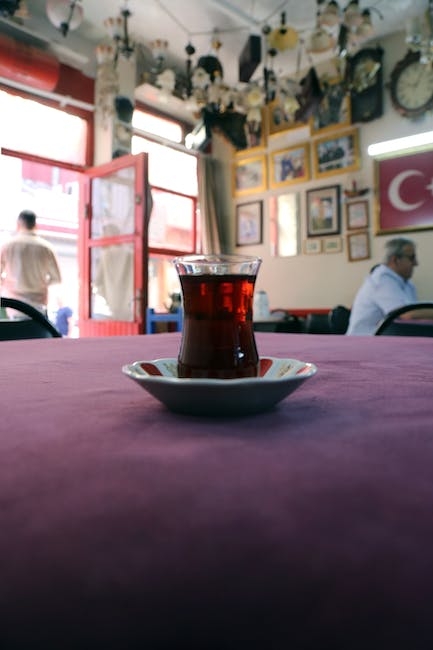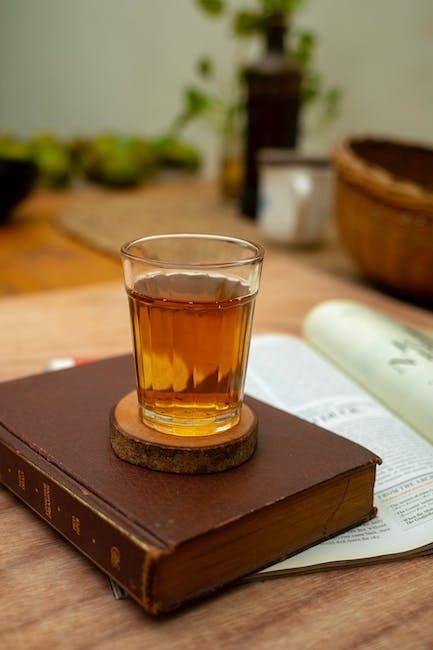Introduction to Ceylon Tea and Orange Pekoe
Tea has been consumed for centuries and is loved by people all around the world. With its soothing aroma and delightful taste, tea has become an integral part of many cultures. If you are a tea lover, then you must have heard of Ceylon tea and Orange Pekoe. In this article, we will explore the fascinating world of Ceylon tea and its most famous variant, Orange Pekoe.
Originally grown in the beautiful island nation of Sri Lanka, Ceylon tea has gained worldwide recognition for its exceptional quality and unique flavor. This tea is produced using the tender leaves of the Camellia sinensis plant, which is grown in the lush green tea estates of Sri Lanka.
Orange Pekoe, on the other hand, is not a flavor or a specific type of tea, but rather a grade classification used in the tea industry. This grade is widely used for black teas and is known for its long, wiry leaves that are full of flavor.
Now that we have an introduction to Ceylon tea and Orange Pekoe, let’s dive deeper into the world of this fascinating tea and learn more about its history, production process, and the benefits it offers.
What is Orange Pekoe?
Before delving into the history and production of Ceylon tea with Orange Pekoe, let’s first understand what Orange Pekoe actually is. Despite its name, Orange Pekoe has nothing to do with the flavor or aroma of oranges.
Orange Pekoe is a term used to classify the leaf size and quality of black teas. It refers to the unbroken, young leaves of the tea plant, often with a silvery tip. These leaves are harvested before they fully open, at the peak of their flavor and aroma. The use of the word “orange” in Orange Pekoe is believed to have stemmed from the Dutch word “oranje,” which means royal. This classification was originally used to denote finer teas and has since become a standard in the tea industry.
Orange Pekoe tea leaves are known for their long, wiry appearance. They are carefully picked and processed to retain their natural flavors and aromas. The classification system ranges from whole leaf (OP) to broken leaf (BOP), with Orange Pekoe being one of the highest-quality grades.
It’s worth noting that Orange Pekoe can refer to black tea from various regions, including Sri Lanka (Ceylon), India, and China. However, when we talk about Ceylon tea with Orange Pekoe, we are specifically referring to the black teas produced in Sri Lanka.
Now that we have a better understanding of what Orange Pekoe is, let’s explore the rich history of Ceylon tea and the popularity of Orange Pekoe in this charming island nation.
History of Ceylon Tea and Orange Pekoe
The history of Ceylon tea dates back to the 19th century when British colonialists introduced the tea plant to the scenic hills of Sri Lanka, then known as Ceylon. The favorable climatic conditions and fertile soil of this island made it an ideal location for cultivating tea.
Initially, Ceylon’s tea industry faced many challenges, including disease and competition from other tea-growing regions. However, with perseverance and innovation, the industry gained momentum and eventually flourished. Today, Ceylon tea is renowned worldwide for its high quality and distinctive flavors.
Orange Pekoe gained popularity as a preferred grade of Ceylon tea due to its delicate flavors and fragrance. The bright and golden liquor produced by Orange Pekoe teas quickly captivated the palates of tea enthusiasts around the globe.
In the early days of Ceylon tea production, the leaves were hand-picked by skilled workers, ensuring that only the finest young leaves were selected. Over time, the tea industry in Sri Lanka evolved, adopting modern machinery and techniques to achieve higher levels of efficiency while maintaining the integrity of the tea.
Today, Ceylon tea with Orange Pekoe continues to thrive as one of Sri Lanka’s main exports. The tea estates, nestled amidst breathtaking landscapes, attract tourists from all corners of the world who wish to witness firsthand the artistry of tea cultivation and processing.
From its humble beginnings to its present-day prominence, the history of Ceylon tea and Orange Pekoe is a testament to the dedication and passion of the people involved in its production. Now, let’s delve into the fascinating process of how Orange Pekoe tea is made.
How is Orange Pekoe Made?
The journey of Orange Pekoe tea starts with the careful selection of young tea leaves from the Camellia sinensis plant. These leaves are hand-picked, ensuring that only the top two leaves and the bud are harvested. This careful selection process ensures that the tea leaves maintain their optimum flavors and aromas.
Once the leaves are harvested, they undergo a process called withering. This involves spreading the leaves out in a well-ventilated area, allowing them to lose moisture gradually. The withering process can take several hours, depending on the weather conditions. This step is essential to prepare the leaves for the next stage of production.
After withering, the leaves are subjected to rolling. Traditionally, this was done by hand, where the withered leaves were gently rolled to shape and release their flavors. However, modern tea production employs mechanical rollers that mimic the gentle hand-rolling action.

Following rolling, the leaves undergo a process called fermentation or oxidation. The rolled leaves are spread out in a controlled environment, where they are exposed to oxygen. This oxidation process allows the leaves to develop their characteristic flavors and dark color. The length of fermentation depends on the desired flavor profile, with shorter fermentation resulting in a lighter tea and longer fermentation producing a stronger brew.
Once the desired level of fermentation is achieved, the leaves are subjected to the final step – drying. This is done either by traditional methods of sun-drying or through commercial drying equipment. The goal is to remove any remaining moisture from the leaves and enhance their shelf life.
After the drying process, the tea leaves are sorted and graded according to their size, shape, and quality. The highest-grade tea leaves are classified as Orange Pekoe, known for their long, wiry appearance and rich flavors.
Now that we have explored the intricate process of making Orange Pekoe tea, let’s move on to the next section and uncover the many benefits of enjoying Ceylon tea with Orange Pekoe.
Benefits of Ceylon Tea with Orange Pekoe
Ceylon tea with Orange Pekoe offers a delightful and refreshing experience for tea lovers, but it also comes with a range of health benefits. Let’s explore some of the advantages of including this tea in your daily routine.
Rich in Antioxidants: Orange Pekoe tea is packed with antioxidants that help protect your body against the damaging effects of free radicals. These antioxidants, such as polyphenols, help reduce the risk of chronic diseases and promote overall well-being.
Boosts Heart Health: Regular consumption of Ceylon tea with Orange Pekoe has been associated with improved heart health. The flavonoids present in the tea can help lower blood pressure, reduce bad cholesterol levels, and improve blood circulation, therefore reducing the risk of cardiovascular diseases.
Enhances Digestion: The natural compounds in Orange Pekoe tea have been shown to aid in digestion, helping to relieve bloating, indigestion, and other gastrointestinal issues. It can also promote healthy gut bacteria, aiding in overall digestive health.
Boosts Immunity: The high levels of antioxidants and polyphenols in Orange Pekoe tea can help strengthen your immune system. Regular consumption may help protect against common illnesses and promote a healthier immune response.
Improves Mental Alertness: The moderate caffeine content in Ceylon tea with Orange Pekoe can provide a gentle energy boost, increasing alertness and focus. It can also help improve cognitive function and enhance overall mental well-being.
Hydrating and Calming: Like any tea, Ceylon tea with Orange Pekoe is a hydrating beverage that can help replenish your body’s fluid levels. Additionally, the mild flavor and soothing aroma of this tea can have a calming effect, making it an excellent choice for relaxation and stress relief.
These are just a few of the many benefits you can enjoy by incorporating Ceylon tea with Orange Pekoe into your daily routine. Now, let’s move on to the final section of this article, where we’ll explore the best ways to enjoy this exquisite tea.
Best Ways to Enjoy Ceylon Tea with Orange Pekoe
Now that you have learned about the rich history, production process, and benefits of Ceylon tea with Orange Pekoe, let’s explore some of the best ways to enjoy this exquisite tea.
1. Hot Brew: The traditional way to enjoy Ceylon tea with Orange Pekoe is by brewing it hot. Bring water to a boil and pour it over a teaspoon of tea leaves in a teapot. Let it steep for 2-3 minutes, or adjust the steeping time according to your preference for a stronger or milder brew. Strain the tea into cups and savor the aromatic flavors and earthy notes of Orange Pekoe.
2. Iced Tea: For a refreshing twist, you can also enjoy Ceylon tea with Orange Pekoe as iced tea. Prepare a strong brew by steeping the tea leaves for a longer time. Once brewed, let it cool, then pour it over ice in a glass. Add a slice of lemon or a sprig of mint for a burst of freshness. It’s a perfect choice for warm summer days.
3. Tea Lattes: Get creative with your Ceylon tea with Orange Pekoe by turning it into a delicious tea latte. Brew a strong cup of tea and warm some milk. Mix the brewed tea with steamed milk and add a touch of sweetener if desired. Sprinkle some cinnamon or chocolate shavings on top for an indulgent treat.
4. Tea Cocktails: Take your enjoyment of Ceylon tea with Orange Pekoe to the next level by using it as a base for refreshing tea cocktails. Mix the brewed tea with your choice of alcohol, such as gin or vodka. Add some citrus juice, a splash of soda water, and a garnish of fresh herbs or fruit. Cheers to a delightful and sophisticated beverage!
5. Tea Infused Recipes: Explore the versatility of Ceylon tea with Orange Pekoe by incorporating it into your cooking and baking. Use brewed tea as a marinade for meats or a base for sauces. Infuse it into your cakes, cookies, or ice cream for a unique flavor profile. The possibilities are endless when it comes to incorporating this tea into your culinary creations.
There you have it, a variety of ways to indulge in the flavors and aromas of Ceylon tea with Orange Pekoe. Whether you prefer a hot cup of tea to start your day or a refreshing iced tea on a sunny afternoon, this exquisite tea is sure to delight your senses and enhance your tea-drinking experience.
So, why not treat yourself to a cup of Ceylon tea with Orange Pekoe and immerse yourself in the rich heritage and flavors of this exceptional beverage? Cheers to the joy of tea!


Leave a Reply